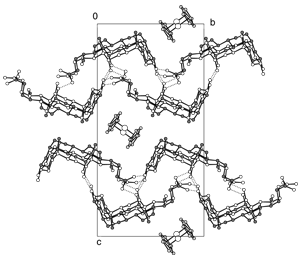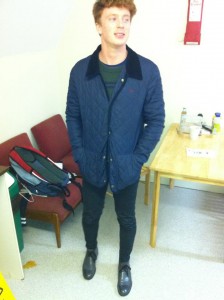 Will is working with Nick Rees, looking into the host/guest complexes of deoxycholic acid. Using variable temperature single crystal diffraction, along with Solid State NMR and Differential Scanning Calorimetry the project is particularly focused on phase changes within the crystal as a function of temperature. When not in the lab he enjoys long lunches, and competing for the Oxford Modern Pentathlon team.
Will is working with Nick Rees, looking into the host/guest complexes of deoxycholic acid. Using variable temperature single crystal diffraction, along with Solid State NMR and Differential Scanning Calorimetry the project is particularly focused on phase changes within the crystal as a function of temperature. When not in the lab he enjoys long lunches, and competing for the Oxford Modern Pentathlon team.
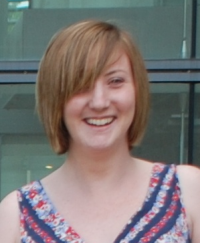 Emma’s research is focussed on developing a better understanding of the solid state. She is using a three pronged attack, studying the crystallisation of chalcones; examining the effect of temperature on a material that undergoes a phase transition, and investigating the World’s Favourite Space Group, P21/c. She is using a wide range of probes, including the Cambridge Structural Database, dSNAP, Laue Diffraction, Solid State NMR and Variable Temperature Single Crystal Diffraction as well as collecting data at Diamond. When not fighting to grow crystals or preparing dinner for the team at Diamond, she enjoys dancing, but refuses to perform for the group.
Emma’s research is focussed on developing a better understanding of the solid state. She is using a three pronged attack, studying the crystallisation of chalcones; examining the effect of temperature on a material that undergoes a phase transition, and investigating the World’s Favourite Space Group, P21/c. She is using a wide range of probes, including the Cambridge Structural Database, dSNAP, Laue Diffraction, Solid State NMR and Variable Temperature Single Crystal Diffraction as well as collecting data at Diamond. When not fighting to grow crystals or preparing dinner for the team at Diamond, she enjoys dancing, but refuses to perform for the group.
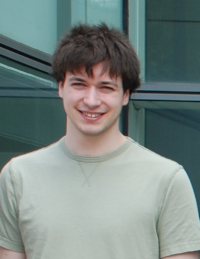 Jeremy’s research revolves around using various techniques (NMR, crystallography and DFT calculations) to provide information about exactly where hydrogen atoms are located in crystal structures, and exploring the merits and shortcomings of the various techniques for this purpose. When he isn’t trying to persuade a supercomputer to calculate what he wants, he enjoys playing the trumpet with the Oxford University Big Band, plays squash and designs prize-winning posters.
Jeremy’s research revolves around using various techniques (NMR, crystallography and DFT calculations) to provide information about exactly where hydrogen atoms are located in crystal structures, and exploring the merits and shortcomings of the various techniques for this purpose. When he isn’t trying to persuade a supercomputer to calculate what he wants, he enjoys playing the trumpet with the Oxford University Big Band, plays squash and designs prize-winning posters.
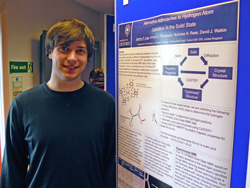 Jeremy Law, a Part II student working with Dr Nick Rees and Dr David Watkin, has won a prize for his poster entitled “Alternative Approaches to Hydrogen Atom Location in the Solid State”. He presented his work to the joint ISIS Crystallography User Group and British Crystallographic Association PCG/SCMP meeting “Current Research in Physical Crystallography”
Jeremy Law, a Part II student working with Dr Nick Rees and Dr David Watkin, has won a prize for his poster entitled “Alternative Approaches to Hydrogen Atom Location in the Solid State”. He presented his work to the joint ISIS Crystallography User Group and British Crystallographic Association PCG/SCMP meeting “Current Research in Physical Crystallography”
Chirality (2008), 20(7), 863-870. Â Â [ doi:10.1002/chir.20561 ]
3 alpha,12 alpha-Dihydroxy-5 beta-cholan-24-oic acid (deoxycholic acid DCA) is able to discriminate between the R- and S-enantiomers of camphorquinone and endo-(+)-3-bromocamphor and select only the S-enantiomers from a racemic mixture. DCA forms novel well ordered 1:l adducts with (1S)-(+)-camphorquinone and (1S)-endo-(-)-3-bromocamphor, both of which have been characterized by single crystal X-ray diffraction (SXRD). When DCA is cocrystallized with (RS)-camphorquinone and (RS)-endo-3-bromocamphor, 1:1 adducts of the S-enantiomers are produced together with crystals of the free racemic guest. In contrast, in the absence of (1S)-(+)-camphorquinone, DCA forms a 2:1 adduct with (1R)-(-)-camphorquinone. In this 2:1 adduct the guest is disordered at ambient temperature and undergoes a phase change in the region 160-130 K similar to that observed for the ferrocene adduct, but with only partial ordering of the guest. The SXRD structure of the low temperature form and the variable temperature C-13 CP/MAS NMR are reported. Cocrystallizing DCA with (1R)-endo-(+)-3-bromocamphor gives the free guest and a glassy solid.
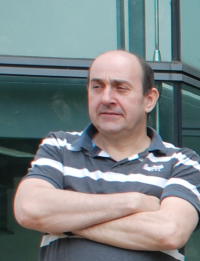 Nick is Inorganic Nuclear Magnetic Resonance Manager. Although he comes from The Dark Side, solid state NMR has its uses and he not only works closely with us, but he is also continuing the work he carried out with Keith Prout on deoxycholic acid complexes. As such he is an honorary member of Chem. Cryst.
Nick is Inorganic Nuclear Magnetic Resonance Manager. Although he comes from The Dark Side, solid state NMR has its uses and he not only works closely with us, but he is also continuing the work he carried out with Keith Prout on deoxycholic acid complexes. As such he is an honorary member of Chem. Cryst.
